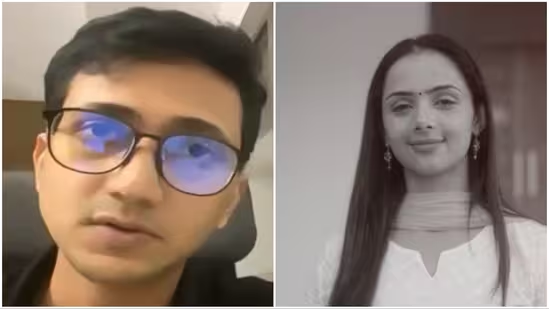Silence, Spotlight, and Shock — The Radhika Yadav Murder Case and Actor Inamulhaq’s Statement
The country woke to disbelief as news broke about the tragic and violent death of Radhika Yadav, a rising Indian tennis player whose career had only just begun to ascend national prominence. Her murder shocked not only the sports fraternity but also millions who had come to know her recently—not on the court, but through a viral music video that captured the public imagination. At the heart of this video was another figure, actor Inamulhaq, whose quiet screen presence suddenly found itself at the centre of a public storm.
When Radhika was found dead in a case now registered as a homicide, early media reports were quick to connect dots—some speculative, some circumstantial. The video, which featured both Inamulhaq and Radhika, resurfaced on social media within hours of the murder being reported. Rumours flooded Twitter and WhatsApp alike, drawing wild conclusions about their relationship, the timing of the shoot, and whether Inamulhaq knew more than he was saying.
The actor’s eventual response came days later—not through a press conference or a TV appearance, but in the form of a brief but firm statement: “She has no social media presence. Please verify facts. I knew her only professionally.” Inamulhaq’s words, while attempting to distance himself from the online frenzy, also opened up a broader discussion on public trials by social media, especially in the aftermath of high-profile crimes.
What remains clear is that Radhika Yadav’s murder is a tragedy that demands a serious, factual investigation, not a narrative spun by memes and unfounded speculation. Authorities have since confirmed that Inamulhaq is not a suspect and has been cooperative in sharing information related to their professional collaboration.
Still, the case raises uncomfortable questions: Who was Radhika Yadav, really? What systems failed to protect her? Why did her presence in a viral video become the pivot of a murder investigation’s public discourse rather than the circumstances of her death?
Over the coming parts, we will explore the many layers of this case. From Radhika’s early life and career in tennis, to the timeline of events leading up to her death, the role of law enforcement, the impact of digital misinformation, and how celebrity involvement—however peripheral—can skew public focus from justice to sensationalism.
This tragedy isn’t just about a promising life cut short. It is also about how quickly stories are written, characters assigned, and conclusions drawn—often at the expense of truth.
Before headlines turned her into a tragic symbol of violence and lost potential, Radhika Yadav was a name familiar in India’s junior tennis circuit. Born in Indore, Madhya Pradesh, into a modest family with no history in sports, her path to athletic recognition was forged not in elite academies, but on sunburnt clay courts of municipal grounds. The murder that has now cast a shadow over her name must not eclipse the story that preceded it—a story of grit, discipline, and relentless hope.
Radhika was 12 when she first picked up a tennis racquet, encouraged by a school coach who noticed her hand-eye coordination during a PE session. Lacking resources but not determination, she trained with borrowed equipment, waking before dawn to practice before school. Her parents, both schoolteachers, could not afford private coaching, but they supported her dream in every way they could—skipping meals to buy tennis shoes, traveling on buses for district-level tournaments, and even taking loans to cover training camps.
By age 16, Radhika was a fixture in state-level competitions. Her breakthrough came at the All India Under-18 Championship, where she reached the semi-finals against better-funded and professionally coached players. Observers began taking note—not just of her agility and baseline game, but of her resilience. “She wasn’t the most powerful player,” her coach, Asha Jagtap, once said. “But she read the court like few others. Her calm under pressure was mature beyond her age.”
Off the court, Radhika was humble and introspective. She kept a low profile on social media, rarely posted selfies, and preferred silence to self-promotion. She had recently completed her Class 12 exams and was preparing to apply for sports quotas at Delhi University and Mumbai’s SNDT Women’s University. For her, tennis was more than sport—it was a lifeline out of socio-economic limitations, a way to lift her family, and an identity she carved on her own terms.
Her dedication did not go unnoticed. In 2024, she was selected as part of a youth sports development program sponsored by a private foundation that provided coaching scholarships and exposure trips. Her travels for training took her to Mumbai, where she would eventually appear in a promotional music video—a small non-commercial collaboration organized by an agency that occasionally partnered with athletes for cross-industry branding.
This appearance was a brief footnote in her growing resume. The video, later viral, was shot during an off-season training break. It was not meant to be a publicity move for either Radhika or actor Inamulhaq but part of a generic youth anthem-style project highlighting sports and perseverance. Ironically, that footage now circulates more widely than any of her tournament wins or training features.
Those who knew her describe her as intensely focused, with a quiet charm. Her few Instagram posts were limited to pictures of tennis shoes, inspirational quotes, or grainy images of scoreboards. In a digital age, Radhika was a rarity—an athlete who let her racquet do the talking.
The tragedy of her death is compounded by the life she was building. She was days away from her next interstate tournament, and her last message to her coach had been about working on her serve. Her ambition was never fame—it was recognition through performance, not virality.
The final days of Radhika Yadav’s life now lie under a microscope—scrutinized by investigators, debated on social media, and mourned by a public struggling to make sense of yet another promising life cut short. As sensational headlines threaten to blur the facts, a more grounded account has begun to emerge, thanks to police briefings, CCTV reviews, and statements from people close to her.
According to Mumbai Police, Radhika arrived in the city roughly a week before her death to participate in a short promotional shoot and undergo tennis training at a private facility in Andheri. She was staying in a modest service apartment arranged by her agency. Her daily routine included morning fitness sessions, on-court drills, and occasional promotional assignments—all confirmed through GPS logs, digital messages, and trainer testimonies.
She was last seen alive around 7:45 PM on July 6, returning to her room after a light dinner near Oshiwara. Surveillance footage from her building lobby shows her entering the premises alone. What happened after that is the subject of a murder investigation now being led by the Mumbai Crime Branch.
At approximately 6:10 AM the next day, the building’s housekeeping staff reported a foul smell and noticed bloodstains near the entrance to her flat. The door was locked from inside. Police were called and had to force entry. Inside, they discovered Radhika’s lifeless body in the bedroom—fully clothed, with visible head trauma and signs of asphyxiation. A tennis racquet lay broken near the window. No signs of forced entry were found, leading investigators to initially suspect someone known to her may have been involved.
The postmortem report confirmed the cause of death as blunt force trauma followed by manual strangulation, ruling out accidental causes. Importantly, no signs of sexual assault were detected, and toxicology reports returned clean. These findings, while grim, helped narrow the motive and timeline.
Police recovered her mobile phone, which had been switched off at 8:13 PM—just under 30 minutes after she entered her apartment. Call logs revealed no unusual activity except for a brief WhatsApp voice note sent to her mother saying, “All good, practice was tight today. Will rest early.” That message was sent at 7:57 PM. Her mother told investigators that Radhika sounded “normal, if a little tired.”
By July 8, three suspects had been questioned—two acquaintances from her Mumbai training circuit and a junior video assistant involved in the recent shoot. No arrests were made in the first 48 hours, prompting online backlash. However, law enforcement sources clarified that evidence collection and digital forensics were still underway and that “building a water-tight case requires patience and precision, not headlines.”
One troubling development came when footage from a nearby ATM captured a man in a black hoodie using Radhika’s debit card at 10:52 PM, hours after her estimated time of death. That suspect has not yet been identified, but the card’s usage has provided valuable geo-location data for investigators.
Actor Inamulhaq, who was briefly dragged into the public narrative due to his appearance with Radhika in a music video, issued a statement asserting that their interaction was strictly professional and that he was not in Mumbai during the period in question. His statement has been corroborated by phone tower data and flight logs.
As speculation grew online, the Mumbai Police issued a formal appeal urging the public and media to avoid misreporting and trial by internet, stating, “We are pursuing every lead with seriousness. But undermining the process by circulating false narratives helps no one—least of all the victim.”
Even as the investigation progresses, many close to Radhika are calling for a broader reckoning—not just with the criminal, but with the ecosystem that too often overlooks women’s safety in professional spaces. Whether it’s sports, entertainment, or media collaborations, young women are frequently left to navigate murky terrain with little protection.
As the investigation into Radhika Yadav’s murder progresses, police have begun tightening the circle of inquiry, shifting from basic fact-finding to forensic correlation, witness verification, and the difficult task of distinguishing public noise from prosecutable evidence. Nearly two weeks since her death, the Mumbai Crime Branch has not yet announced a formal arrest, but behind the scenes, a complex web of digital traces, personal connections, and behavioral patterns is being pieced together.
At the center of the investigative focus are three persons of interest: two male acquaintances from the local tennis and sports media community who were in frequent contact with Radhika during her Mumbai stay, and one unidentified man seen using her ATM card posthumously—captured on grainy CCTV exiting a petrol station in Malad West. All three have been either questioned or placed under digital surveillance.
Police sources confirm that the ATM card was used three times between 10:52 PM and 3:12 AM, indicating a degree of planning and an effort to capitalize on the victim’s death. The fact that the phone was turned off shortly after Radhika’s last known activity suggests the perpetrator was not only known to her but may have acted with calculated precision, eliminating potential surveillance from her device.
Moreover, a critical clue came from trace DNA collected from under Radhika’s fingernails, suggesting a possible physical altercation. The lab has confirmed a partial profile, now being compared against local databases. Meanwhile, apartment building records revealed that Radhika had not registered any overnight guests and no third-party keys were recorded—raising the likelihood that either the attacker was let in willingly or was already present at the time of her arrival.
Legal experts familiar with the case have raised concerns over the speed of the process, urging caution. “In cases of public scrutiny, there’s always pressure to arrest someone quickly,” says criminal lawyer Vidya Naik, who has handled several high-profile cases in Maharashtra. “But rushed action without solid evidence risks weakening the case later. What the police need is not just a narrative, but court-admissible proof.”
Complicating matters is the media circus surrounding the incident. Multiple digital outlets—some credible, many not—have run speculative pieces linking Radhika to everyone from fellow athletes to music video producers, often without verification. The damage this causes is twofold: it pollutes public perception and interferes with witness cooperation, as potential informants become reluctant to speak for fear of being vilified or misquoted.
To counteract this, Mumbai Police have implemented a media blackout on specific forensic updates. The move has drawn criticism from sections of the press but is defended by law enforcement as “necessary to protect the integrity of the investigation.” In parallel, the Maharashtra State Forensic Science Laboratory has fast-tracked its analysis of Radhika’s personal belongings, including her laptop, phone, and smartwatch—hoping to reconstruct her final interactions and detect any digital coercion or intimidation.
One crucial angle being probed is online harassment. While Radhika had no active Instagram or Twitter account, records indicate she received repeated direct messages and spam emails through her sports foundation profile, many of which were unsolicited offers to “collaborate” on modeling and digital shoots. Her coach confirmed she had recently expressed discomfort about “a few unknown people insisting on meeting her” after the video release.
In India, online harassment often slips through legal cracks. While the Information Technology Act and IPC Sections 354(D) (stalking) and 509 (word, gesture or act intended to insult modesty of a woman) exist, enforcement is weak without a formal complaint—a gap that has left many young women vulnerable to escalating threats. Radhika’s case, tragically, may add to a growing list of situations where early red flags were ignored or brushed off as digital noise.
As for the legal route ahead, a first charge sheet is expected within 30 to 45 days, depending on evidence consolidation. If the DNA match is established and the ATM suspect identified, charges could include IPC Sections 302 (murder), 201 (causing disappearance of evidence), and 394 (robbery with violence). In case of more complex digital exploitation or coercion, cybercrime elements may be introduced under Section 66 of the IT Act.
But the legal trajectory is only part of the narrative. Equally vital is the emotional fallout among Radhika’s family, her community, and the many aspiring athletes who saw in her a model of progress and independence. The trauma has reignited discussions around athlete safety, especially for women navigating training circuits, travel alone, and appearances in public or entertainment platforms.
The death of Radhika Yadav, an emerging star in Indian tennis, is more than a criminal investigation—it is a mirror held up to the fragile systems meant to protect the young, ambitious women who represent the future of Indian sports. Her tragic end has reignited a national conversation not just about violence, but about institutional negligence, fragmented safety frameworks, and the price women pay for daring to dream independently in male-dominated spaces.
While India has produced champions like Sania Mirza, PV Sindhu, and Mary Kom, their success stories often mask a harder truth: for every female athlete who makes it to the international stage, hundreds remain unprotected, underfunded, and unheard, navigating a maze of unregulated coaches, isolated training camps, and frequent exposure to unknown intermediaries.
Radhika’s case starkly highlights this vulnerability. She was traveling alone for training and minor sponsorship appearances. There was no dedicated team manager, no female chaperone, and no grievance redressal system in place from her sports federation. Her accommodation was booked via a third-party vendor; background checks of adjacent apartment units weren’t required. She was, in essence, a young woman operating in a professional zone without a protective net—a scenario far too common in the junior sports ecosystem.
Despite government promises, most State Sports Authorities (SSAs) and national federations lack enforceable policies around gender-sensitive logistics. While the Ministry of Youth Affairs and Sports has issued guidelines for safeguarding athletes—especially minors and women—they are recommendations, not obligations. Compliance audits, where they exist, are paper formalities. No regulatory body tracks whether a female athlete has access to safe travel, secure housing, mental health counselors, or even a confidential helpline while on tour.
When contacted, a senior official from the All India Tennis Association (AITA) admitted, under condition of anonymity, that “infrastructure for safeguarding players is still evolving,” especially in non-elite levels of the game. “We have anti-harassment policies, but enforcement is patchy and depends on the state-level units.” In short, the system expects women to self-protect in an environment that rarely supports them.
Radhika’s coaches, devastated by her loss, have since called for an overhaul. In a public statement, her mentor Asha Jagtap said, “She was a brilliant talent. But we failed her. Not just as individuals, but as an institution. Her safety was not prioritized, and that is unacceptable.”
The vulnerability doesn’t end on the ground—it’s amplified online. Following Radhika’s viral appearance in a music video, she began receiving a surge of digital attention, most of it unsolicited. While her social media presence was minimal, her image had already entered the algorithmic echo chamber, exposing her to strangers who blurred professional admiration with personal intrusion. Her coach recalled that Radhika felt “uncomfortable” with the attention but didn’t know how to disengage without seeming ungrateful or rude.
This underscores a key problem: young athletes today must navigate fame without guidance. Agencies and sponsors frequently involve them in promotional content, but rarely offer media training, legal briefing, or digital safety support. In Radhika’s case, the video shoot was a harmless appearance meant to inspire youth—but the aftermath was anything but. The fetishization of female athletes is a documented pattern, one that creates a predatory environment masked as fandom.
There are also important questions for law enforcement. Should there be mandatory tracking of athletes during outstation training assignments? Should federations be held liable for failing to assign athlete welfare officers? Why don’t junior athletes have secure housing programs modeled on military cantonments or protected sports hostels, especially in urban centers like Mumbai?
Some change may now be on the horizon. Following public pressure, the Sports Ministry has announced a review committee to look into existing athlete safety guidelines, especially for women. Several NGOs have called for the immediate rollout of athlete protection officers in every state-run sports facility. But whether these measures will go beyond rhetoric remains to be seen.
Perhaps the most tragic aspect of Radhika’s story is that it could have been prevented—not just the murder, but the isolation, the systemic silence, and the lack of proactive support that left her vulnerable in the first place. Her name should not just be remembered as a victim of a violent crime. It should be a symbol of why India’s approach to athlete development must include protection, not just performance metrics.
Also Read : Indian Tennis Player Radhika Yadav Shot Dead by Her Father in Shocking Incident








